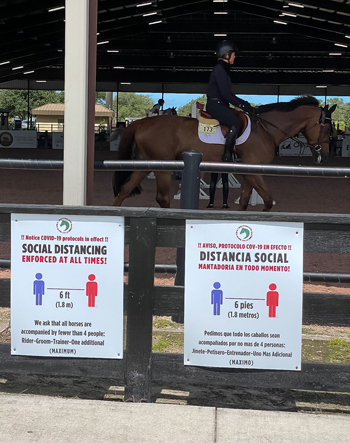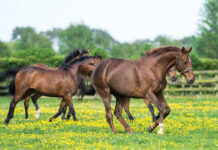
Equestrians and equine business owners nationwide, and in Canada, share their stories of how they’ve been dealing with the COVID-19 pandemic. Their stories give a glimpse at the inevitable negative impacts to the horse industry as a whole and also the resiliency of horse people to keep on keeping on with their horses.
Changes to Business
Meagan Maloney operates Tiara Equine, a dressage and eventing barn with a Knabstrupper breeding program in Stouffville, Ontario, Canada. Maloney reported in mid-May that they had been closed to the public due to COVID-19 governmental restrictions for two months, but that she was starting to hear inconsistent news that they may be allowed to reopen soon.
Getting Home
When her Ontario barn closed in March, Maloney was still in Florida with 10 horses and says that their trip home was harrowing with delayed health papers, cancelled commercial drivers, and border crossing difficulties. In the end, she and her assistant trainer each had to drive a vehicle to get the horses home, posting about their trip on social media, which generated much-needed moral support. Once home, she self-quarantined for 14 days before returning to her barn.
She says she found two families to foster some of their retired school horses and was able to lease out a sales horse to help with finances during the shutdown.
Pandemic Precautions
Maloney lists ways she and the equestrians at her barn are coping with the COVID-19 pandemic shutdown. “We’ve made a video for clients to see what precautions we are taking within the barn,” she says. “We recently started paddock visits for one client at a time to come visit their horse safely. I have offered discounted training programs to clients, so we have 24 horses in three to five days of training a week. My ‘schoolies’ are still in work too; we want to minimize risk of injury by ensuring they are ready when we reopen.
“I encouraged our partial boarders to continue their part-board by offering a portion of their costs back to them in the form of ‘lesson cash’ that essentially provides free lessons when we return,” she continues. “We’re currently running a makeover fundraiser by offering a spring clean-up of the horses. My staff took ‘guess who’ photos while they worked, depicting a series of eyes or ears or noses [of the horses], and sent them out to make a little competition for the clients who couldn’t visit.”
Speaking of staff adjustments, Maloney and her staff have been quite innovative in dealing with the challenges of the pandemic by working split shifts with no crossover, cleaning in between shifts, and color-coding tools and supplies with each staff member assigned a different color for their tools.
A Tight Ship to Start
In Snow Camp, N.C., FEI dressage rider Eliza Sydnor Romm runs a dressage training program with 12 to 14 horses in full training and has several employees. She specializes in starting young horses and also travels to teach.
“I closed it down on March 24 to everyone but myself, my assistant trainer and one barn worker,” says Sydnor Romm. “We would work the horses each day and send pics and videos to the clients. Around April 10, I decided to let my full training clients come back for regular riding. But, we get their horse ready and put the horse away afterwards. They keep their boots and helmet with them in their car so that they don’t ever need to come in the barn.”
Technology Tips
During her pandemic barn closure, Sydnor Romm started two new YouTube projects, the first being an exercise of the day for her clients and the other a video series on how to start a young horse. “#ExerciseOfTheDay was an idea to keep my students engaged, but has spread much farther than just my own students,” she says. “I have a gorgeous young horse in training that I am starting. So, I took this opportunity to do something I had thought about doing for years and am making a series of videos on how I start young horses. It’s come out better than I’d hoped, and people seem very engaged with it.”
She says she was able to continue giving some of her private lessons to equestrians durign the COVID-19 pandemic that were within reasonable driving distance by making use of earbuds and the rider’s cell phone or plugging their earbuds into her wireless headphone information system and then wiping it down between clients.
She also has started teaching a few remote lessons and thinks they are fun and work well, because she has no overhead, and it takes her less time since she doesn’t have to drive anywhere. She plans to return to showing in her area at the end of June so that she can trailer in for the day. She expects to go to shows further afield in the fall, if all goes well.
Back to Showing
Moving to Florida, Equestrian Sports Productions (ESP) in Wellington hosted some of the earliest shows for equestrians after restrictions began to lift from the COVID-19 pandemic shutdowns. They staged schooling shows in late May and early June at the Palm Beach International Equestrian Center, putting in place the United States Equestrian Federation’s biosecurity safety measures, which effectively made them a “beta test” for restarting equestrian competition.
Michael Stone, president of ESP, sums up how it went. “The new protocols are working well,” he says. “The vast majority of people are complying and are very respectful of each other and the situation. At the very beginning, we had a few holes in the access points to the venue, but we fixed them very quickly.”
Trials for the Trail Riders
Midwest Trail Ride Horsemen’s Campground in Norman, Ind., is adjacent to the 203,000-acre Hoosier National Forest. The 69-acre facility normally hosts campers and day riders from early April to early November, but the state-mandated closure cost them two of their busiest months, which really hurt.
“We are normally busiest in April and May and then again in the fall,” explains Kim Humphries, who is co-owner with her husband, Jeff. “Since we were allowed to open Memorial Day weekend, we have been busier than normal so far through mid-June. We hope that this trend continues, but we have to wait and see.
The Humphries have re-spaced the parking areas and the configuration of the cabins and brought in a professional crew for a deep cleaning, in addition to their normal daily routine. They also provide spray bottles of disinfectant for campers to use in the shower house and bathrooms before and after they use the facilities.
Boarding Barn Adjustments
In southwestern Illinois near St. Louis, amateur equestrian and mathematician Jen Emig boards her Thoroughbred gelding Eli at a public barn. She reports that her barn closed to all but boarders and people leasing horses who were allowed to visit their horses only during scheduled times. Only boarders could have lessons, which were scheduled for 30 minutes during one-hour time slots so that there was no overlap between clients. The maximum number of clients at the barn at any one time was limited to one horse owner or lessee visiting their horse and one rider that was taking a lesson. A parent could accompany their child to the barn.
Emig talked about what it was like in Illinois, which announced its stay-at-home order on March 20. “On March 22, we started having to sign up online for hour slots using [the app] Sign Up Genius. We sanitize the things everyone touches at the barn. We have wipes and sprays right when you walk in the door, as well as around the barn. My barn requested that everyone wear masks in common areas, and our lounge is closed. The barn owner also alternated times for farriers and vets to visit. Our barn’s June show was cancelled, and the owner says he has lost quite a bit of money.”
Working Ranch Workarounds
In Hempstead, Texas, near Houston, Alexis Ellison works for a large working ranch and polo operation. Ellison also breeds and trains sport horses and is a farrier. In early June, she outlined what happened in their state, saying that they did have shutdowns of schools and businesses and practiced social distancing. But for her, life on the ranch was fairly isolated anyway.
Ellison still had to care for the animals and train horses. And her farrier business was only impacted a small amount. Organized polo matches and shows were put on pause in Texas and only resumed in mid-May. She headed out to her first show since the pandemic began on the first weekend in June.
“I think the experience of people like me, who live far outside a city, is vastly different than what your average city dweller has been through,” she shares. “Luckily [since] the agriculture services I provide are a necessity, I was able to get through this without significant financial stress. My heart goes out to all those people who are not so lucky. The new normal is definitely challenging. We have sanitizer in all the work trucks and horse trailers here on the ranch and minimize high-traffic situations.”
Tourism Tanks During COVID-19
Bitterroot Ranch near Yellowstone National Park in Dubois, Wyo., and their related Equitours Company, are both owned by the Fox family. The third week of March, they feared they would not be able to open either business in 2020. Fox shared the following update on June 13: “We have been open for two weeks but have had many bookings postponed. It will be a very bad season, the worst in 50 years. Most dude ranches in Wyoming will not open this year.”
City vs. County Restrictions in California
In California, according to Marnye and Larry Langer of Langer Equestrian Group, equine-related activities fell under the heading of “essential services,” but it was difficult to tell exactly what that meant. “It was further complicated by the fact that various counties had different levels of restriction,” explains Marnye Langer. “We had non-horse people writing requirements for horse operations. As time progressed, we worked closely with the trainers at Hanson Dam Horse Park and worked out some protocols where horse owners could come to the property and start to ride.”
As of early June, Los Angeles County had given them reopening protocols to follow, but re-starting shows in California had not yet been achieved, mostly due to conflicting city and county restrictions across California. The Langers pointed to another equestrian sector casualty of the pandemic—cancelling shows equals lost jobs.
“I began to feel like my theme song was Queen’s ‘Another One Bites the Dust.’ In one week alone I sent eight show cancellation notices to USEF,” she says. “It is so hard to see staff, officials, and the many, many people who rely on horse shows for a significant portion of their income really struggling. This situation points out one of the challenges our industry needs to grapple with, the many people who live right on the margin. Many of the workers in our industry don’t have savings and also were not eligible for unemployment.”
The Langers know the social aspect of horse showing is important to most people, even those competing at the highest levels, and that it will be difficult to get used to this new normal. But, they remain optimistic and feel that equestrians will rise to the occasion. “New ways of having fun at a horse show will arise,” says Marnye Langer. We need to stay open-minded and creative.”
The Unknowns of Summer Camp
California-based eventer Lisa Sabo reported in mid-June that since her operation is based out of the state-owned Orange County Fairgrounds where there are a lot more restrictions in place, she is still not fully back to business there. “At the fairgrounds, we maintain social distancing, and when we are on foot we must wear masks. Right now, we can exercise horses there, but that’s it.”
Sabo explains that in her area some private barns have already started to reopen, so for now she has moved part of her program to a farm where there are fewer restrictions. She and her husband Brian have both an eventing competition barn and the Newport Mesa Riding Center, with a string of 12 lesson horses who have to be cared for. While the competition barn suffered from a lack of income, the riding school went into the red quickly when the shutdown was imposed.
She is a big believer in educating youth to develop the next generation of equestrians. “We need to feed our sport from the base,” she says. “We normally run summer camps, but I don’t think we are going to be able to this year. But, we are super hopeful that we can still have some sort of modified horsemanship classes for the children this summer while maintaining the COVID-19 distancing rules.”
Moving into the summer of 2020, equestrian activities have resumed in much of North America, but the pandemic has also spiked again in a number of locations.
HorseIllustrated.com invites you to share COVID-19 coping ideas from your stable in the comments below so that all equestrians can unite and safely enjoy our horses and our sport.






